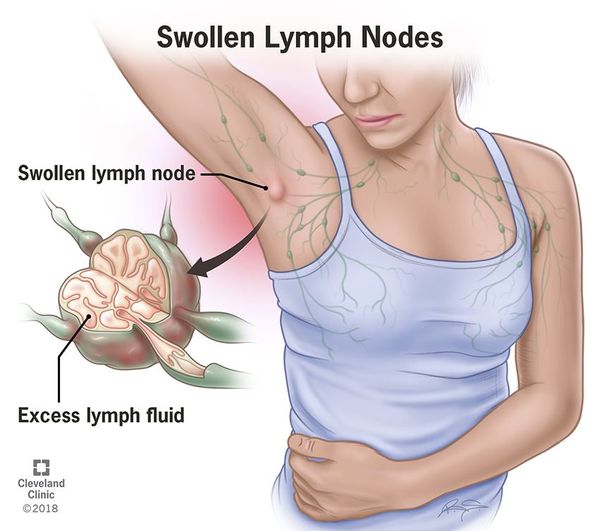A: Very possible and normal, specifically on the side you received the vaccination.
Throughout your body, hundreds of lymph nodes work to filter your lymphatic fluid. When your body is mounting an immune response, after an infection or a vaccine, lymph nodes can swell with fluid. Lymph nodes are located all over our bodies, with clusters present in our armpits. Axillary (fancy word for armpit) lymph nodes filter lymphatic fluid from your arm and your chest. Lymph nodes closer to immune system action are more likely to swell. For example, when you have an infection that affects your throat, you often feel swollen lymph nodes in your neck. Swollen lymph nodes can be uncomfortable.
In clinical trials, 11-16% of participants aged 18 to 64 who received the Moderna COVID-19 vaccine reported axillary swelling and tenderness. The rate was lower, 6-8%, for people over the age of 65. This symptom was not specifically reported in the Pfizer trials, but remains a possibility given the similar mechanism of action in the two vaccines.
* So what do I do?
Monitor, manage pain, modify screening plans, and make a call to your health provider if you are worried.
Monitor – Most symptoms are mild and will resolve on their own. The revving of your immune system lasts well beyond your injection, so it is reasonable to have some discomfort for days to a few weeks after your vaccination. Symptoms that become severe or persists after 2-4 weeks should be further investigated.
Manage pain – In trials, most who reported axillary discomfort described it as mild pain. Pain may be exacerbated by certain movements or pressure. So, avoid the uncomfortable movements when possible and avoid pressure from restrictive clothing, like underwire bras. You can use a warm compress to the area to ease discomfort as well. For more significant pain, you can use Acetaminophen or Ibuprofen for temporary pain relief as compatible with your other conditions. When in doubt, call your doctor.
Modify screening plans – Even if your armpit doesn’t hurt, your lymph nodes may be swollen. This is a normal and expected response to the vaccine on the side of the injection. If you are scheduled to have a screening mammogram in close proximity to your vaccine, it’s possible the test will detect vaccine-related axillary lymph node swelling. A swollen lymph node on imaging can create further uncertainty, fear, and further testing. If you are scheduled for a screening mammogram and recently had a COVID-19 vaccine, let your provider know. They may recommend delaying the screening test up to 6 weeks based on guidance from the Society of Breast Imaging. This only applies to people who are having preventative screening mammograms and not individuals undergoing active work up (diagnostic) imaging for a specific concern or diagnosis.
Make a call to you provider – When in doubt, make a call to your provider. A brief phone call to discuss your symptoms can provide piece of mind and initiate necessary care as needed.
Additional resources:
Axillary (Armpit) Tenderness Symptoms in COVID-19 vaccine clinical trials
Covid-19 vaccination and mammograms

Image Credit: Cleveland Clinic


